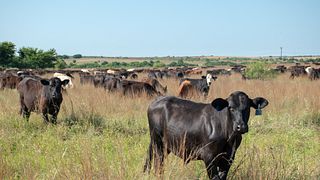The Fall Run
The long-held tradition of the “Fall Run” continues to be a driving force for not only our South Dakota Farmers and ranchers but also our communities. The economic role it plays in supporting family livelihoods as well as main street businesses helps in keeping our South Dakota communities strong and vibrant. It creates a very busy time for producers, communities, and sale barns. Steve Hellwig, Hub City Livestock of Aberdeen, SD, states, “The fall run is looked upon, for most people, about like pheasant season is looked upon for hunters. Everybody gears up for it and your veterinarians get busy, your truckers get busy, people are weaning the calves, the feed companies get busy, it’s the time of year when everybody gets back to work. Feed companies, truckers, veterinarians with their vaccines and medicines, everything hinges on the fall run.”
South Dakota, split by the Missouri River, has variations within their cattle population with the majority of the west river ranches considered cow/calf operations. Their run will consist of mostly calves between 8 to 9 months of age being brought through the barns. As you travel to the eastern side of the state you will see this change with the addition of feeder cattle operations alongside the cow/calf producer. With the variation in cattle numbers, the Fall Run varies depending on what side of the state you are on. Hellwig, located on the eastern side of the state, states, “We get around 80,000 head of cattle through our barn in October, November, and December with approximately 30-40% of those being calves with the remainder 50,000 to 60,000 head being feeder cattle.”
Livestock Auction Markets have a huge role during fall run. “You have to have a relationship with the people that are selling as well as the people that are buying,” states Hellwig. Hellwig says many calves go to the same people every year and it is important to get the word out ahead of time. Putting the word out on who is selling which calves and on which day is very important in keeping things running smoothly. Hellwig says, “There’s a lot going on, there’s a lot of cattle moving so there is a lot to do to get that to be as organized and as efficient as possible as well as flexible. With the weather we’ve had this year, many dates have been changed for producers.” Hellwig states they make quite a few phone calls and a lot of communication needs to be had during this time of year to make sure things run smoothly.
What does the livestock auction market role look like? One of their roles includes helping their customers make important decisions. “One of the biggest challenges beef farmers and ranchers face is the price of the cattle. Should they sell all of the calves, should they just sell the steer calves, should they keep replacement heifers back this year... etc. That’s when we work with a lot of producers by going into their operation and helping them decide what to do,” states Hellwig. “We often try to help give advice on what these calves are worth or what we think they’ll bring, and then we make a plan with them on what we want to do.” To learn more about the Fall Run, the role of livestock auction markets, and raising beef cattle visit https://www.beefitswhatsfordinner.com/raising-beef
